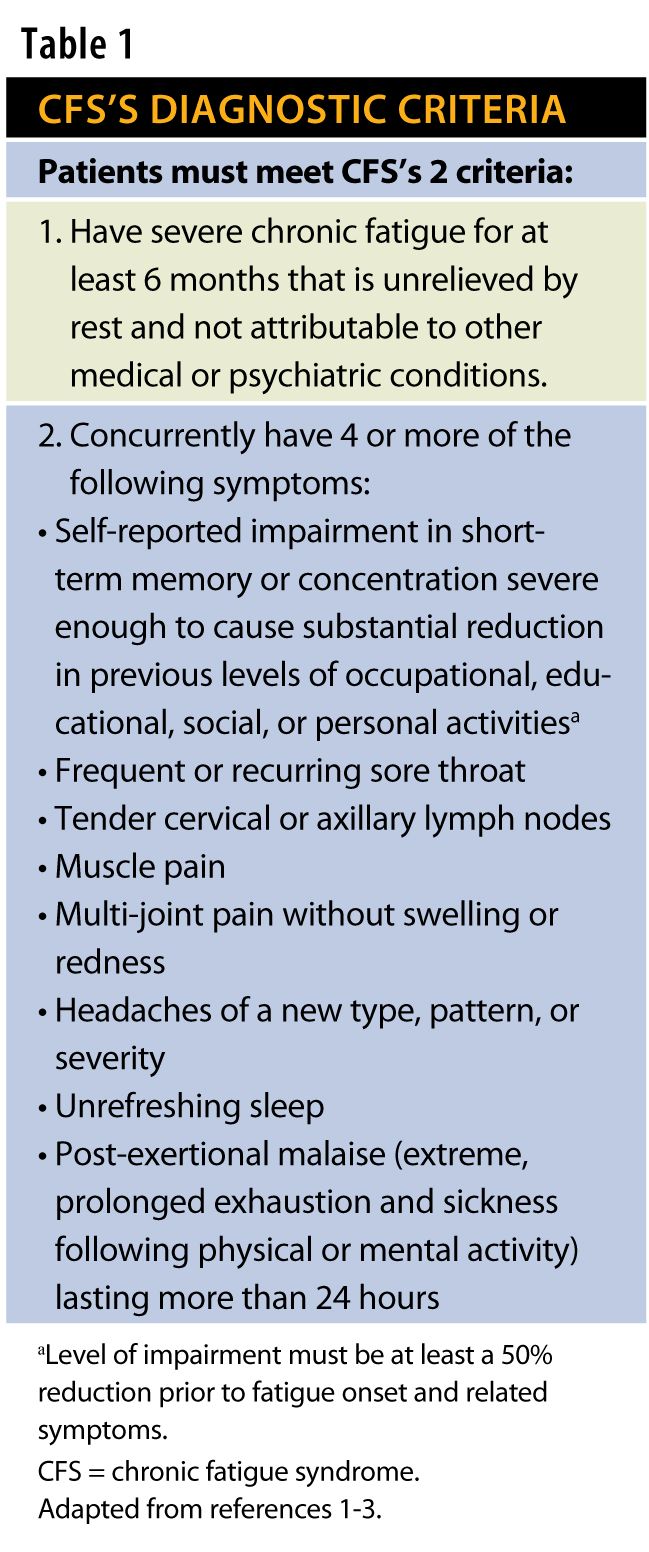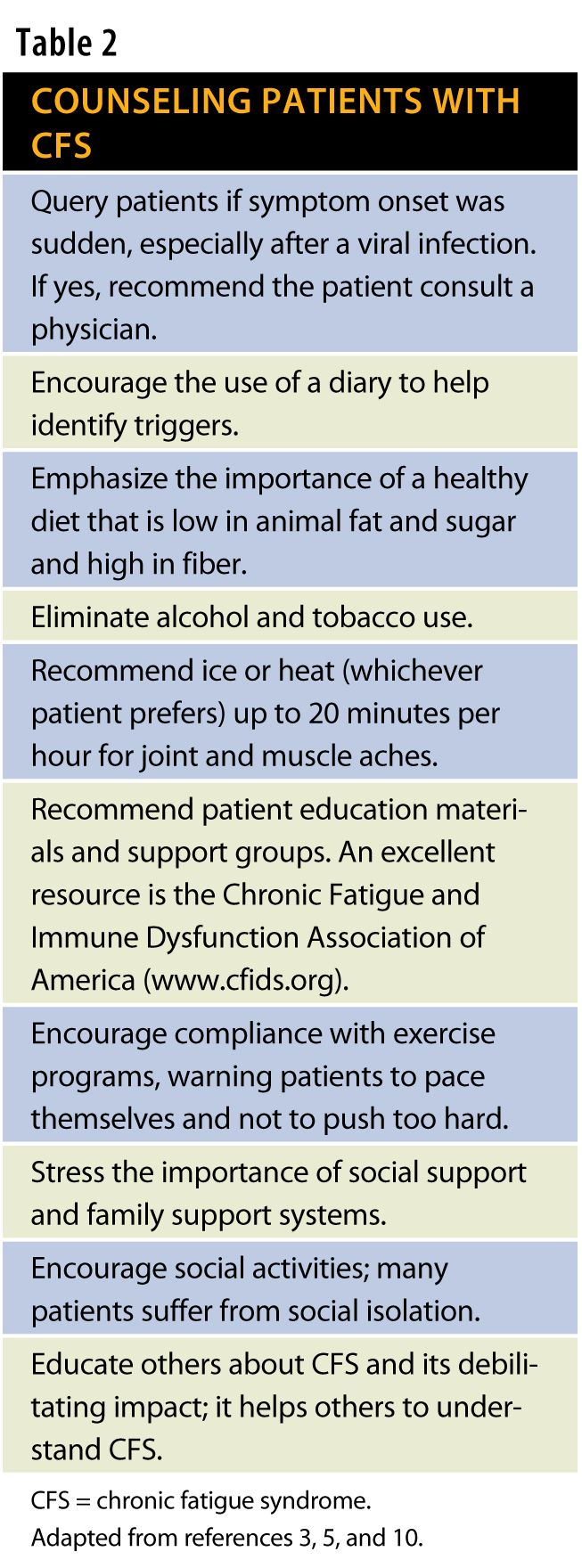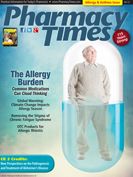Publication
Article
Pharmacy Times
Removing the Stigma of Chronic Fatigue Syndrome
Author(s):
Patients may struggle to get an accurate diagnosis and find an effective treatment plan.
Patients may struggle to get an accurate diagnosis and find an effective treatment plan.
Chronic fatigue syndrome (CFS) is a complex, debilitating disorder charac­ terized by overwhelming fatigue con­ current with several other symptoms that worsen with physical and mental activ­ ity. Unlike normal fatigue, rest and sleep bring no relief.1

CFS—also referred to as myalgic encephalomyelitis—is a relatively new disorder, first recognized in 1988. Along with symptoms listed in Table 1, patients with CFS also present with multiple non­ specific symptoms, including irritable bowel; depression; chills and night sweats; visual disturbances; dizziness; balance problems; allergies; and increased sensi­ tivity to foods, odors, chemicals, medica­ tions, or noise.1
Approximately 4 million Americans have CFS. Onset is sudden, occurring between 40 and 50 years of age. CFS is 2 to 3 times more common in women, and researchers estimate that fewer than 20% of patients have been properly diagnosed.
Symptoms tend to remit and recur with significant variability and severity.4 Some symptoms appear to have triggers, such as exposure to pesticides or cleaning flu­ids.5 Each outbreak tends to differ from previous episodes, but when in remission, patients are rarely asymptomatic.4 Several comorbidities are associated with CFS, especially depression, which is present in 28% of cases. Sleep and neurocognitive disorders are likewise common.4
CFS’s etiology remains unknown, although there is support for a genetic link. Because many patients experience onset following viral infections, research initially focused on this pathogenic rela­tionship, but findings are inconclusive. Other theories include immunologic dysregulation, orthostatic intolerance, brain abnormalities, endocrine dysfunc­tion, neurally mediated hypotension, and environmental toxins.2 Although there is limited evidence for various theories, no single pathophysiologic explanation can be linked to all cases.2,4
Assessment
It takes an average of 5 years from symp­tom onset to diagnosis, although it is not unusual for some patients to see providers for up to 10 years before being diagnosed.3,4 CFS has no known diagnostic test; diagno­sis relies solely on clinical intake. Diagnosis is a process of excluding other causative factors for symptoms, including Lyme dis­ease, depression, sleep disorders, substance and alcohol abuse, diabetes, hypothyroid­ism, lupus, or multiple sclerosis.2
Treatment
CFS has no known cure. Therapeutic approaches to CFS are complex, requiring a combination of modalities. Symptom management, patient education, and periodic assessment are treatment’s main objectives. Symptom management foc­ uses on 4 interventions.
Pharmacotherapy
People with CFS are unusually sensitive to medications, and practitioners begin with dosages below the recommended level for a therapeutic response.6 This is likewise true for OTC prod­ ucts, vitamins, and other supple­ ments.6 Some patients turn to complementary and alternative medicine (CAM) for relief; how­ ever, one meta­analysis conclud­ ed that there is limited evidence for recommending CAM for patients with CFS.7
Patient-Specific Exercise Program
Because of post-­exertional malaise, patients are reluctant to exercise. Graded exercise therapy (GET) is recommended to increase exercise tolerance. GET con­ sists of multiple, daily, structured exer­ cises involving brief periods of exertion (as little as 1 minute) followed by rest. Generally, the ratio of exercise to rest is 1:3.8 Studies report GET results in less fatigue and improved psychologic and cognitive functioning.4 Once exercise is terminated, however, patients may return to their former level of fatigue.6,8
Lifestyle Changes
Lifestyle changes positively impact CFS. Along with a healthy diet and eliminating alcohol and nicotine, patients must adhere to an exercise program. For CFS sufferers who are bedbound, physical therapists devise appropriate exercise protocols.
Cognitive Behavioral Therapy
Cognitive behavioral therapy (CBT) focuses on an individual’s thoughts and attitudes and their influence on behav­ iors. CBT helps patients develop coping skills and strategies for everyday activi­ ties. Combining CBT with GET is one of the most effective CFS interventions, with a Cochrane review reporting 40% improvement compared with 26% for usual care. Improvement ended, however, when treatment was terminated.4

Recovery rates vary. Some studies report up to 37% for total recovery and 63% for some level of improvement. One­third of patients relapse within 6 months, however.2 Patients with severe CFS and those with the greatest num­ Patients with severe CFS and those with the greatest number of symptoms have the poorest prognoses. ber of symptoms have the poorest prognoses. The best prognosis is seen in young adults without concomitant psychiatric disorders.4
Counseling Tips
Patients with CFS express 2 important needs: making sense of their illness and managing and develop­ ing strategies for symptom relief.3 Many patients live with frustration, depression, and stress because friends and relatives summarily dis­ miss their symptoms. Many are relieved when they are diagnosed with CFS; it validates the legitimacy of their symptoms. Pharmacists need to be sympathetic and supportive for patients complain­ ing about chronic fatigue. Because many agents have side effects that mimic CFS’s symptoms, counseling begins by review­ ing current medications, including dosages, because patients with CFS are high­ly sensitive to recommended dosages. Table 2 highlights other important points to guide pharmacists when counseling patients with CFS.
Final Thought
Clinicians’ lack of empathy is a common experience.3 Finding a supportive coun­seling pharmacist can have a strong posi­tive impact on patients who are coping with CFS.
Dr. Zanni is a psychologist and health systems consultant based in Alexandria, Virginia.
References
1. Centers for Disease Control and Prevention. Chronic fatigue syndrome. www.cdc.gov/cfs/general/index.html. Accessed January 23, 2012.
2. Chronic Fatigue and Immune Dysfunction Association of America. About CFS reach. www.cfids.org/about-cfids/research.asp. Accessed January 25, 2012.
3. Drachler Mde L, Leite JC, Hooper L, et al. The expressed needs of people with chronic fatigue syndrome/myalgic encephalomyelitis: a systematic review. BMC Public Health. 2009;9:458.
4. Avellaneda Fernández A, Pérez Martín A, Izquierdo Martínez M, et al.
Chronic fatigue syndrome: aetiology, diagnosis and treatment. BMC Psychiatry. 2009;9(suppl 1):S1.
5. National Women’s Health Resource Center, Gale Cengage Learning. Chronic fatigue syndrome. March 16, 2005.
6. Chronic Fatigue and Immune Dysfunction Association of America. About CFS treatment. www.cfids.org/about-cfids/treatment.asp. Accessed January 25, 2011.
7. Alraek T, Lee MS, Choi TY, Cao H, Liu J. Complementary and alternative medicine for patients with chronic fatigue syndrome: a systematic review. BMC Complement Altern Med. 2011;11:87.
8. Centers for Disease Control and Prevention. Chronic fatigue syndrome, managing activity and exercise. www.cdc.gov/cfs/general/treatment/managing_activity.html. Accessed January 23, 2012.
9. Natelson B. Treatment FYI: controlling pain. www.cfids.org/cfidslink/2007/100306.pdf. Accessed January 30, 2012.
10. Health & Wellness Resource Center. Chronic fatigue syndrome. CareNotes. February 1, 2011.










